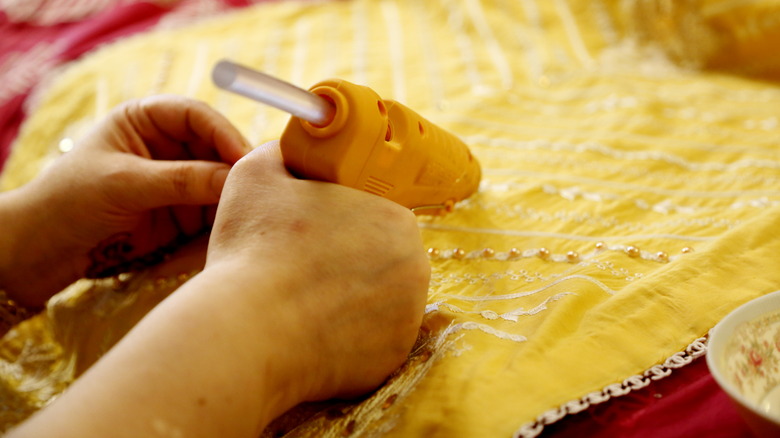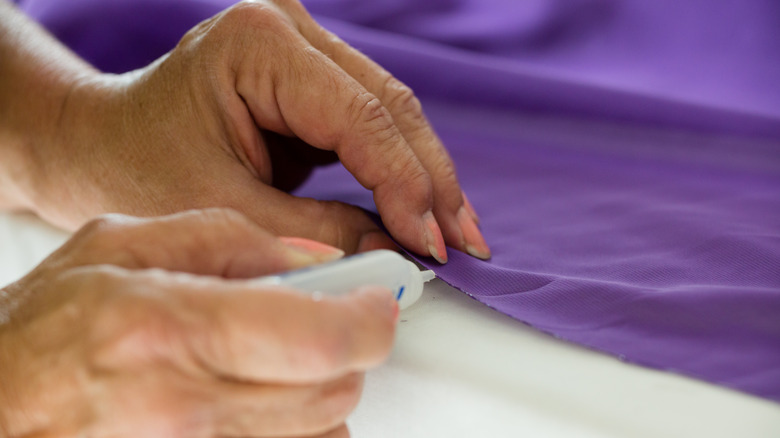15 Types Of Glue You Should Have On Hand For Home & Garden Upkeep
There's nothing easier than applying a little bit of glue to fuse the broken handle on your partner's favorite coffee mug, secure the wobbly leg on your wooden furniture, or sticking mulch around your plants to minimize yard work. But, you can only take quick action if you have the requisite glue at hand. So, to ensure you always have the right kind of adhesive on hand, we've created a list of types to stock up on. These include masonry, contact cement, wood, fabric, hot melt, multipurpose, and super glues you should own for home and garden upkeep.
However, simply stocking up on these glues isn't enough. You must read their label carefully to know the types of materials they're compatible with. After all, you wouldn't want to use wood glue as a no-sew alternative while DIY-ing new covers for your couch cushions. Similarly, you don't want to use hot glue on pipes and fittings. You'll also need to consider an adhesive's water-resistance and bond level, or you could accidentally use an indoor glue outdoors. Plus, you want to use a respirator mask and work in a well-ventilated area to avoid inhaling the chemical fumes. And, remember to wear gloves and keep any toxic adhesives out of the reach of pets and children.
1. Mulch glue will keep your garden neat and tidy
Are you tired of strong wind, rainfall or irrigation, and water overflow displacing the mulch around your plants? Use mulch adhesive to bid this problem goodbye. These tackifiers are compatible with most natural mulches and are made from non-toxic polymers and supplements that are safe for the soil, your pets, and the environment. However, if you'd rather use a non-toxic adhesive in your yard, you can DIY mulch glue for your flower beds. Besides, you can use mulch glue on landscaping rocks to keep the wayward stones and pebbles in place. The only caveat? This isn't a permanent solution and you'll have to reapply the glue regularly.
2. Hot glue gun will help bring your DIY projects to life
The sturdy cylindrical glue sticks are a household staple and a must-have in your arsenal of tools if you're a connoisseur of DIY projects or crafting. Applied using a specially-designed gun, the stick melts when heated and cools quickly to solidify and connect varied items together, including paper, wood, cardboard, fabric, decorative items, glass, and more. Available in multiple colors and varied levels of transparency, hot melt adhesives are generally composed of thermoplastic elastomers and supplementary resins.
3. Instant glue will help you repair broken household items
Popularly known by the brand names, Super or Krazy glue, cyanoacrylate adhesive is the perfect glue for bonding broken household items, like vases, plates, and mugs. This adhesive is ideal for bonding wood, metal, leather, ceramics, glass, stone, rubber, vinyl, and almost all types of plastic. It bonds with the water on a material's surface to forge unbreakable chains, resembling a plastic mesh, on a molecular level. Available in liquid and gel formulations, the acrylic resin glue dries within seconds and is impervious to moisture once it hardens.
4. Fabric glue is a no-sew way to give torn fabrics a second chance
Instead of throwing away your favorite bed sheets sporting a tear or bearing a professional's charges because you're not comfortable with a needle, use fabric glue, like Loctite's Vinyl, Fabric, and Plastic Resin, to make the rips disappear. This type of adhesive is suitable for soft materials that are flexible and change positions regularly, like your garments, upholstery, and bed linens. This water-resistant and long-lasting glue can be used on leather, wood, metal, ceramic, and glass, too.
5. Wood adhesive is suitable for gluing light lumber pieces together
Wood glue might not seem like a necessity in the grand scheme of things, but it's essential for bonding wooden pieces. However, not all wood adhesives are the same and you need to have one (or several) on hand based on the projects you undertake. To illustrate, the PVA version, like Kraken Bond's Super Wood Glue, is the most common and colloquially known as carpenter's glue. Besides this yellow or white adhesive, hide glue (derived from animals) and polyurethane adhesive are ideal for fabricating furniture. On the other hand, epoxy is the best glue for bonding metal to wood.
6. Contact cement will help you install a variety of materials
Contact cement, or contact adhesive, is a rubber-based glue used to fuse large surfaces permanently. Most commonly used for installing laminate countertops, this adhesive can be used to bond non-porous items that are otherwise difficult or impossible to bond with glues, like floor tiles. This is because the adhesive is dry by nature and the solvent evaporates within a short time after application. That being said, the adhesive must be applied to both surfaces for a strong bond. It's suitable for wood, metal, plastic, leather, veneer, and glass.
7. Rubber cement is your best bet when you need strong, flexible bonds
A cousin of contact cement, rubber cement is manufactured using unvulcanized (unprocessed) rubber and a solvent. It can be easily applied to small areas, like fusing leather pieces or the rubber sole of a shoe. The ensuing bond is flexible and can be removed when needed without harming the material it's used to glue together. Further, it's suitable for photos, fabric, foamboard, and paper. That being said, check the glue you buy to see if it leads to temporary fusions or permanent ones.
8. Two-part epoxy adhesives can be used on multiple surfaces
Unlike their one-part sibling, two-part epoxy adhesives come with the resin and hardener separate or in side-by-side tubes like this Gorilla Glue option from The Home Depot. Mixing the epoxy resin with the hardener in a 1:1 ratio leads to an epoxide reaction and gives birth to a strong type of glue that packs a punch when bonding plastic, glass, ceramics, metal, wood, concrete, fiberglass, stone, and tile. It's also used to close fissures and in DIY projects. Remember, the clock starts ticking as soon as you blend the two items. This means you might have a few minutes to a few hours, depending on the glue, to use the epoxy adhesive.
9. Solvent cement is necessary to seamlessly join pipes and fittings
Solvent cement, PVC cement, pipe glue, or PVC glue is an adhesive used to fuse CPVC, ABC, and PVC pipes and fittings together. Although it's categorized as a glue, it's actually a solvent that bonds the molecules of pipes (or fittings) by dissolving the ends and fusing them as one. The strong and durable connection is due to a combination of CPVC resin, solvents, fillers, and stabilizers. It can be used to fix minor leakages, connect pipes, and handle some PVC repairs. You can choose among regular-, medium-, and heavy-bodied solvent cements based on your needs.
10. Spray adhesive is a fuss-free option to bond various materials
Need a fuss-free option to mend your damaged furniture or fix the upholstery? Consider keeping a pressurized can of spray adhesive in your home like LePage's multipurpose product. Its application is seamless and it's compatible with a wide variety of materials, including fabric, plastic, wood, metal, foam, leather, glass, and cardboard. Plus, such glues generally look clear once dry and form strong bonds. However, not all spray adhesives can tolerate heat or humidity, so choose one with caution. You also want to pick between multipurpose and heavy-duty, based on your needs.
11. Polyurethane glue is water-resistant and extremely strong
Polyurethane (PU) glue is a polymer, aka it contains large molecules linked to each other. Most PU adhesives can tolerate moisture and handle temperature fluctuations with ease, making them an excellent option for bonding stone, metal, ceramic, concrete, glass, wood, and foam. Generally, such glues expand during curing to create unbreakable adhesion, so use a small amount with caution. They can be packaged as one- or two-part glue, wherein the former requires moisture to be activated (the original Gorilla glue, anyone?) while the latter acts as epoxy.
12. Construction adhesive is a must for homeowners undertaking construction or renovation projects
Feeling inspired after going through tons of ideas for your kitchen remodel or bathroom project? Well, you need a reliable glue to bring your vision to life. Enter construction adhesive. Available in a variety of versions, such adhesives are moisture- and weather-resistant and can be used indoors and outdoors to fuse metal, wood, plastic, and concrete. For instance, it can assist you in installing subflooring, countertops, molding, roof, paneling, baseboards, drywall, adding insulation, and installing decorative features to the ceiling or wall.
13. Landscaping adhesive is ideal for building hardscaping features
Also known as masonry glue or block adhesive, landscape adhesive like this Titebond version from Tractor Supply Company, is used to build retention walls and set cement paving stones or cap stones in the garden. Additionally, it can help fuse uneven materials and fill crevices. Designed for outdoor areas, these adhesives cure within a few hours, are water-resistant, incredibly durable, and can tolerate wide temperature ranges. Besides brick, concrete, and stone, the adhesive works well on wood, metal, slate, and more.
14. Multipurpose adhesive adheres to almost all materials
Commonly known as E6000 glue, you need multipurpose glue in your home because it forms a permanent bond with almost all kinds of materials, like ceramics, glass, wood, metal, concrete, masonry, vinyl, plastics, leather, marble, rubber, asphalt, and PVC. Plus, it's a self-leveling adhesive that turns incombustible once it's dry. It remains flexible over time, won't dissolve in the dryer or washer, and doesn't turn yellow or disintegrate due to fluctuations in temperature.
15. Plastic glue is necessary to bond plastic components
Plastic is omnipresent in our homes, but it's one of the most challenging materials to use glue on. This is because a lot of adhesives break down with time or don't stick to plastic components adequately. However, you need plastic adhesive, or plastic cement, to bond these flexible materials. But, it's essential to choose the right kind to fuse the item you have on hand, like your kid's toys. For instance, items rated a 6 or labeled "PS" are made out of polystyrenes. Common household items like disposable razors, containers, and packing materials fall under this category, so a product like Loctite's Plastic Binder can repair these when needed.















